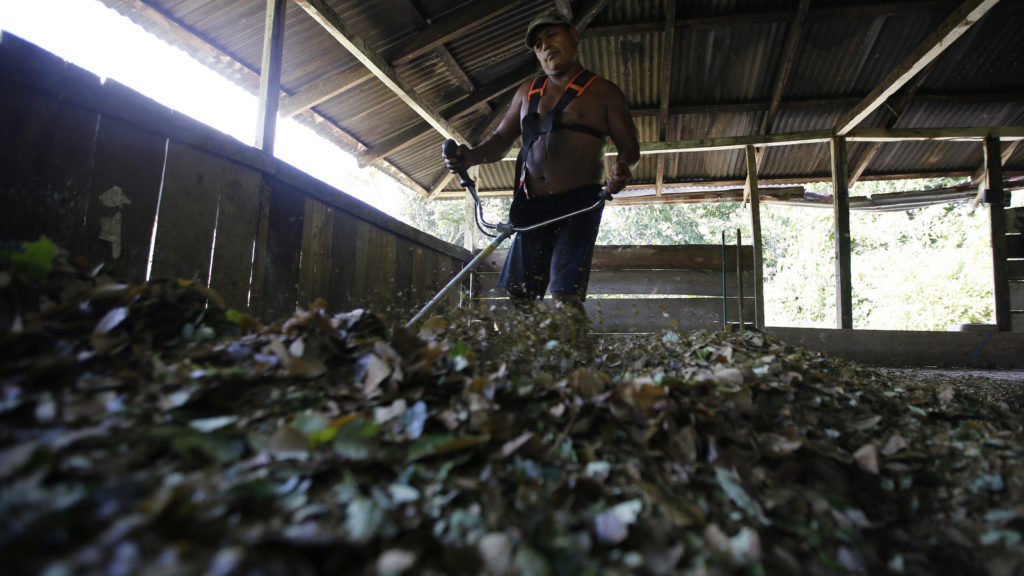16 Years after Onset of U.S. Plan Colombia, Cocaine Profits Reach Record Highs
LATIN AMERICA AND THE CARIBBEAN, 24 Jul 2017
Mint Press News – TRANSCEND Media Service
The U.S.-Colombia drug war alliance has failed to stop the country’s drug trade, with last year’s coca yield breaking records. The record harvests can be traced to the country’s government, right-wing paramilitaries and wealthy individuals who are sympathetic to U.S. business interests.

A man mulches coca leaves with a weed eater at a small makeshift lab in Puerto Bello, Colombia. Coca cultivation surged last year and now covers more territory than it did when a multibillion U.S.-led eradication campaign began 16 years ago. (AP/Fernando Vergara)
20 Jul 2017– Ever since Colombia descended into civil war more than 50 years ago, the country’s notorious drug trade has largely been blamed on the leftist insurgency, the Revolutionary Armed Forces of Colombia (FARC), rather than the government-connected right-wing paramilitaries who have also sold illegal drugs to fund their operations.
The habit of laying the lion’s share of the blame at FARC’s feet came into its own following Colombia’s partnership with the United States in the latter’s war on drugs, particularly when the highly-publicized alliance failed to make any headway in halting cocaine production.
Official cooperation between the two nations began in 1999, when then-President of Colombia Andrés Pastrana Arango showed he was willing to cooperate in the U.S.’ drug war by endorsing a U.S.-funded aerial fumigation program in which glyphosate was indiscriminately sprayed on small family farms in areas that were allegedly producing cocaine. Years later, it emerged that glyphosate, a Monsanto product, is a likely carcinogen.
Related: Colombia To Return To Attacking Coca With Glyphosate
Instead of admitting failure due to short-sighted, ineffective policies and the Colombian government’s mishandling of funds, FARC became the scapegoat, as other sources of cocaine production, namely right-wing paramilitaries, were connected to powerful international corporations and the Colombian government.
But now, the FARC-blaming narrative is falling apart, exposing the uncomfortable truths of Colombia’s drug trade and the decades-long conflict that has come with it. According to the United Nations, Colombia’s cocaine crop yield for last year broke all previous records, increasing by 50 percent from the year prior – which was itself a record-breaking year.
However, as part of a highly-publicized peace deal between FARC and the government – which even netted Colombia’s current president a Nobel Peace Prize – FARC gave up their role in the drug trade following the finalization of the deal last year. Thus, this record-breaking cocaine yield cannot be traced back to FARC alone.
There have long been plenty of other players in Colombia’s drug trade, namely paramilitaries and the Colombian military. Even the United Nations Drug Control Program (UNDCP) has described the Colombian military as being among “the biggest heroin and cocaine trading institutions.” The military is armed and trained by the U.S. under Plan Colombia.
The Colombian government has also been intimately involved, particularly during the presidency of Alvaro Uribe, who allegedly served as the “head of Colombia’s paramilitary groups” both before and while in office. Uribe was once ranked by the U.S. Defense Intelligence Agency as number “82 on a list of 104 important narco-traffickers contracted by the Colombian narcotics cartels.”
Related: How US Corporations Used Personal Armies To Uproot, Terrorize Colombians
There are also indications of the U.S. government’s own involvement in the Colombian cocaine trade. Colombia’s most notorious drug trafficker, Pablo Escobar, at one point worked for the U.S. Central Intelligence Agency, according to Escobar’s own children. Escobar allegedly sold cocaine for the CIA to help the U.S. government finance its fight against communism and left-wing governments in Latin America.
As pointed out in the book “Cocaine, Death Squads and the War on Terror: U.S. Imperalism and Class Struggle in Colombia,” the U.S.’ anti-drug efforts in Colombia were never intended to eradicate cocaine, but instead alter the market share by ensuring that allies of the U.S. in Colombia – the Colombian government, paramilitaries and the wealthy elite who are favorable to U.S. business interests – could monopolize the drug trade with no competition from outsiders. Now, with FARC out of the picture, the true end game of the U.S.-Colombia drug war alliance is becoming harder to cover up.
Go to Original – mintpressnews.com
DISCLAIMER: The statements, views and opinions expressed in pieces republished here are solely those of the authors and do not necessarily represent those of TMS. In accordance with title 17 U.S.C. section 107, this material is distributed without profit to those who have expressed a prior interest in receiving the included information for research and educational purposes. TMS has no affiliation whatsoever with the originator of this article nor is TMS endorsed or sponsored by the originator. “GO TO ORIGINAL” links are provided as a convenience to our readers and allow for verification of authenticity. However, as originating pages are often updated by their originating host sites, the versions posted may not match the versions our readers view when clicking the “GO TO ORIGINAL” links. This site contains copyrighted material the use of which has not always been specifically authorized by the copyright owner. We are making such material available in our efforts to advance understanding of environmental, political, human rights, economic, democracy, scientific, and social justice issues, etc. We believe this constitutes a ‘fair use’ of any such copyrighted material as provided for in section 107 of the US Copyright Law. In accordance with Title 17 U.S.C. Section 107, the material on this site is distributed without profit to those who have expressed a prior interest in receiving the included information for research and educational purposes. For more information go to: http://www.law.cornell.edu/uscode/17/107.shtml. If you wish to use copyrighted material from this site for purposes of your own that go beyond ‘fair use’, you must obtain permission from the copyright owner.
Read more
Click here to go to the current weekly digest or pick another article:
LATIN AMERICA AND THE CARIBBEAN: